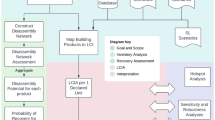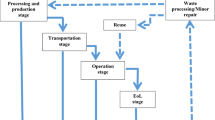Abstract
Purpose
Residential buildings play an important role in consumption of energy resources. About 40 % of all primary energy is used in buildings all over the world. This paper is the second part of the study on the life-cycle energy (LCEA), emissions (LCCO2A) and cost (LCCA) assessment of two residential buildings constructed in urban and rural areas.
Methods
In the first part, the methodology, formulations and procedure for such a comprehensive analysis are provided, while this paper provides an application of the methodology that considers two actual buildings located in Gaziantep, Turkey. The proposed model focused on building construction, operation and demolition phases to estimate energy use, carbon emissions and costs per square meter over a 50-year lifespan. The optimum thickness of insulation used to reduce energy consumption and emissions per square meter is determined.
Results and discussion
It is found that the operating phase is dominant in both urban and rural residential buildings and contributes 87–85 % of the primary energy requirements and 88–82 % of CO2 emissions, respectively. Life-cycle greenhouse gas emissions were 5.8 and 3.9 tons CO2 eqv. for BT1 and BT2, respectively. It is calculated that the life-cycle energy consumption and CO2 emissions of the residential buildings can be reduced by up to 22.8 and 23.4 %, respectively, by using a proper insulation material for the external walls. The life-cycle cost, consisting of mortgage, energy, maintenance, service and demolition payments are calculated to be 7.28 and 1.72 million USD for BT1 and BT2, respectively.
Conclusions
Building envelope developments, such as better wall insulation, provide noteworthy potential energy savings and contribute to the reductions from cooling and space heating. Therefore, primary strategies and technologies needed for efficient buildings include optimal insulation of external walls. The economic insulation thickness of the residential buildings in Gaziantep is determined to be 80 mm by using a life-cycle cost analysis. The results show that because of the differences in building structures and living standards, life-cycle energy intensity and CO2 emissions in urban residential buildings are 29 and 25 % higher than in rural conditions.
























Similar content being viewed by others
References
Atmaca A (2016) Life cycle assessment and cost analysis of residential buildings in South East of Turkey: part 1—review and methodology. Int J Life Cycle Assess (in press)
Atmaca A, Atmaca N (2015) Life cycle energy (LCEA) and carbon dioxide emissions (LCCO2A) assessment of two residential buildings in Gaziantep, Turkey. Energ Build 102:417–431
Atmaca A, Yumrutas R (2014) Analysis of the parameters affecting energy consumption of a rotary kiln in cement industry. Appl Therm Eng 66:435–444
Atmaca A, Kanoglu M, Gadalla M (2012) Thermodynamic analysis of a pyroprocessing unit of a cement plant: a case study. Int J Exergy 11:152–172
Aye L, Ngo T, Crawford RH, Gammampila R, Mendis P (2012) Life cycle greenhouse gas emissions and energy analysis of prefabricated reusable building modules. Energ Build 47:159–168
Chau CK, Leung TM, Ng WY (2015) A review on life cycle assessment, life cycle energy assessment and life cycle carbon emissions assessment on buildings. Appl Energy 143:395–413
Crawford RH, Treloar GJ, Ilozor BD, Love PED (2003) Comparative greenhouse emissions analysis of domestic solar hot water systems. Build Res Inf 31:34–47
Dincer I, Acar C (2015) A review on clean energy solutions for better sustainability. Int J Energy Res 39:585–606
EIA (2006) International Energy Outlook 2006. Energy Information Administration (EIA), #:DOE/EIA-0484. EIA, Washington, pp 1–5
Frischknecht R, Wyss F, Knöpfel SB, Stolz P (2015) Life cycle assessment in the building sector: analytical tools, environmental information and labels. Int J Life Cycle Assess 20:421–425
Grant A, Ries R (2013) Impact of building service life models on life cycle assessment. Build Res Inf 41:168–186
Gurung N, Mahendran M (2002) Comparative life cycle costs for new steel portal frame building systems. Build Res Inf 30:35–46
Gustavsson L, Joelsson A (2010) Life cycle primary energy analysis of residential buildings. Energ Build 2:210–220
Keoleian GA, Blanchard S, Reppe P (2001) Life-cycle energy, costs, and strategies for improving a single-family house, applications and implementation. J Ind Ecol 4:135–156
Langston CA, Ding GKC (2011) Sustainable practices in the built environment. Heinemann, Butterworth
Monteiro H, Freire F (2011) Environmental life-cycle impacts of a single-family house in Portugal: assessing alternative exterior walls with two methods. Gazi Univ J Sci 24:527–534
Monteiro H, Freire F (2012) Life cycle assessment of a house with alternative exterior walls: comparison of three impact assessment methods. Energ Build 47:575–583
Norman J, MacLean HL, Asce M, Kennedy CA (2006) Comparing high and low residential density: life-cycle analysis of energy use and greenhouse gas emissions. J Urban Plan Dev 32:10–21
Ortiz-Rodríguez O, Castells F, Sonnemann G (2008) Life cycle assessment of two dwellings: one in Spain, a developed country, and one in Colombia, a country under development. Sci Total Environ 408:2435–2443
Ramesh T, Prakash R, Shukla KK (2010) Life cycle energy analysis of buildings: an overview. Energ Build 10:1592–1600
Sartori I, Hestnes AG (2007) Energy use in the life cycle of conventional and low-energy buildings: are view article. Energ Build 3:249–257
Shukla A, Tiwari GN, Sodha MS (2009) Embodied energy analysis of a dobe house. Renew Energy 3:755–761
Stephan A, Crawford RH, Myttenaere K (2013) A comprehensive assessment of the life cycle energy demand of passive Houses. Appl Energy 112:23–34
Sterner E (2000) Life-cycle costing and its use in the Swedish building sector. Build Res Inf 28:387–393
Thormark C (2002) A low energy building in a life cycle its embodied energy, energy need for operation and recycling potential. Build Environ 4:429–435
Treloar GJ, Fay R, Love PED, Iyer-Raniga U (2000) Analysing the life-cycle energy of an Australian residential building and its householders. Build Res Inf 28:184–195
TUIK (2013) Turkish Statistical Institute, Population and housing census, no: 15843. http://www.turkstat.gov.tr/PreHaberBultenleri.do?id=15843
Utama A, Gheewala SH (2009) Indonesian residential high rise buildings: a life cycle energy assessment. Energ Build 11:1263–1268
Wade SH (2002) Measuring changes in energy efficiency. Energy Inf Adm EIA 1:1–17
Acknowledgments
The authors acknowledge the support provided by the Scientific Research Projects Unit (GUBAP) at the University of Gaziantep and greatly appreciate Dr. Nihat Atmaca from University of Gaziantep and Mr. Ahmet Selim Ener and Mr. Murat Evyapan from Edacan Construction Company for their cooperation throughout this study.
Author information
Authors and Affiliations
Corresponding author
Additional information
Responsible editor: Alexander Passer
Rights and permissions
About this article
Cite this article
Atmaca, A. Life-cycle assessment and cost analysis of residential buildings in South East of Turkey: part 2—a case study. Int J Life Cycle Assess 21, 925–942 (2016). https://doi.org/10.1007/s11367-016-1051-7
Received:
Accepted:
Published:
Issue Date:
DOI: https://doi.org/10.1007/s11367-016-1051-7




